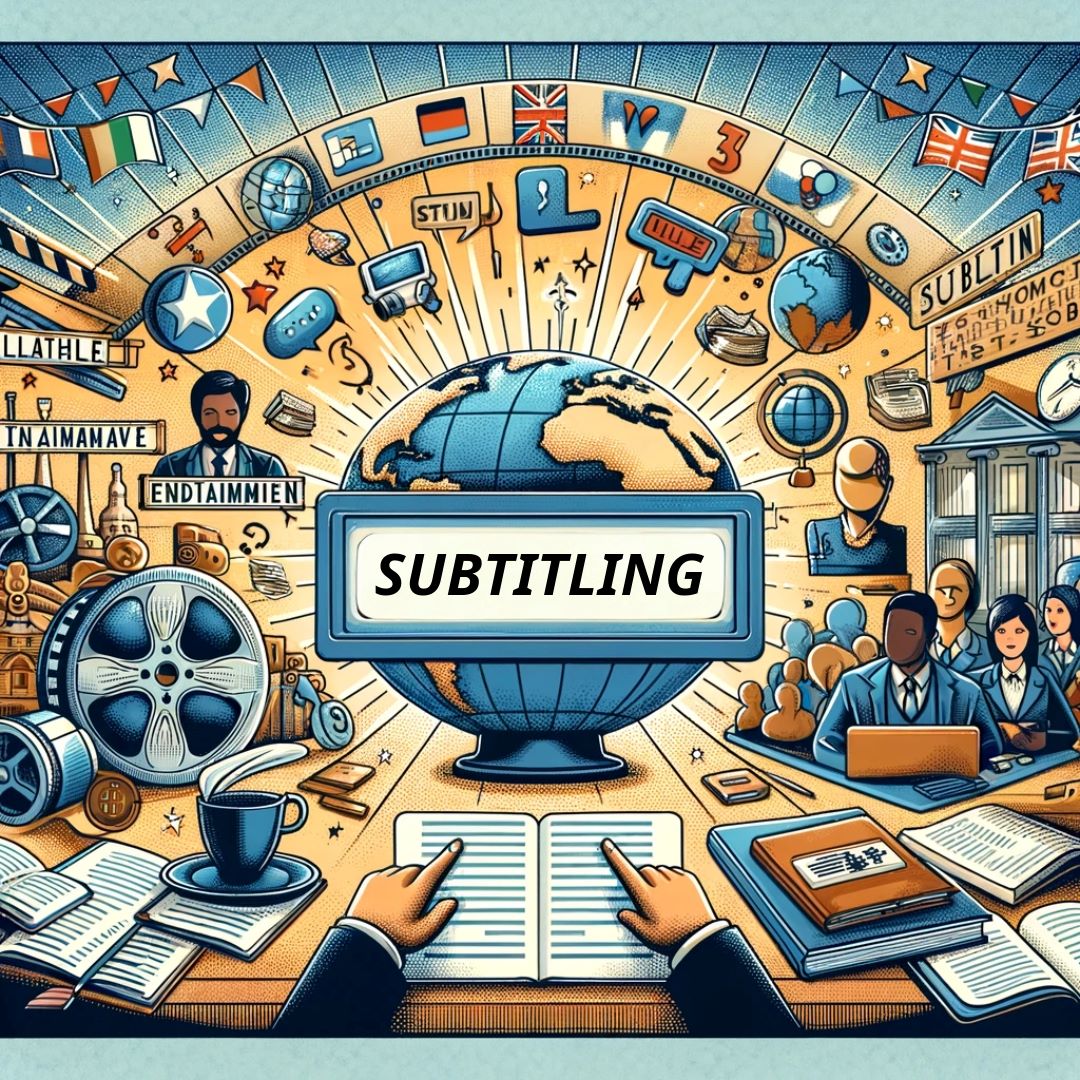In today’s digital age, the power of video content cannot be overstated: the need for accessible and inclusive media has led to a significant rise in audiovisual translation. This transformation is only partly driven by global initiatives to enhance accessibility for those with sensory disabilities.
Beyond compliance, there's a compelling case for organizations across various sectors to embrace subtitling and closed captioning services. Let’s delve into the nuanced world of subtitling, exploring its types, the intricacies of the subtitling process, and the undeniable benefits it offers to companies and audiences alike.
Three varieties of audiovisual translation
The predominant form of audiovisual translation involves multilingual subtitling, also known as interlingual subtitling. This approach entails translating the original language of the media content into a different language for the subtitles.
A second variety is known as same-language subtitling, or intralingual subtitling, wherein the subtitles are provided in the same language as the original media content.
Lastly, there's a specific form of subtitling designed for individuals with hearing impairments, referred to as Subtitles for the Deaf and Hard of Hearing (SDH) in the UK, and as Closed Captioning (CC) in the US.
Understanding the subtitling process
The subtitling process varies based on the materials supplied by the client. Without a script or template, subtitlers rely on the audio to generate subtitles. When provided with a script or a dialogue list, they use it as a reference during translation. If given a timecoded template with original dialogue, subtitlers are typically required to adhere to the existing time cues while inserting their translations.
For productions requiring multilingual subtitles, efficiency is improved by using a source template, which is shared with translators for each target language. Occasionally, an English "pivot" template is produced for videos originally in another language, serving as a bridge for subsequent translations into additional languages.
Mastering subtitling: balancing quality and requirements
The process of subtitling is a meticulous one, requiring a balance of technical precision, creative insight, and a deep understanding of the audience's needs. The art of subtitling is not just about translating words; it's about ensuring that viewers can seamlessly read and understand the text without detracting from the visual experience. Achieving this balance requires attention to various technical and stylistic details that contribute to the overall quality of subtitles.
Readable and comfortable subtitles
The primary goal of subtitling is to create a viewing experience where audiences can effortlessly read subtitles while fully engaging with the visual elements of the content. This delicate balance involves several key factors, including the length of subtitles, their display speed, and how well they integrate with the video's context and visuals.
Subtitle length and speed
Subtitlers meticulously monitor the characters per line (CPL) and characters per second (CPS) to ensure readability. The CPL typically ranges from 37 to 42, ensuring that text is neither too cramped nor too sparse. This measure, however, can be adjusted for specific formats like vertical videos prevalent on social media platforms, where space is at a premium.
The CPS, indicating the speed at which subtitles appear and disappear, usually falls between 15 and 20. This speed may vary, especially for content aimed at children, to accommodate their reading pace. The objective is to allow enough time for viewers to read each subtitle without feeling rushed or lagging behind the on-screen action.
Layout considerations
Understanding the video's genre, the context of the dialogue, and the overall layout of the subtitles is paramount. Subtitles should be positioned to minimize disruption to the visual narrative, typically centered at the bottom of the screen. However, flexibility is required when on-screen text or crucial visual elements necessitate moving subtitles to avoid overlay.
Moreover, subtitlers often face the challenge of translating on-screen text and lyrics that are essential to the plot, requiring a keen sense of how to incorporate these elements seamlessly into the subtitles without confusing the viewer.
Guidelines and style guides
The subtitling process is governed by detailed guidelines and style guides, which may vary depending on the client's preferences or the country's standards. These guidelines cover everything from the minimum and maximum duration of subtitles (usually 1 to 7 seconds) to specific considerations for different types of content. Such standards ensure a uniform and high-quality viewing experience across various platforms and media types.

The importance of quality
High-quality subtitles are not just a courtesy but a necessity: they not only make content accessible to a wider audience, including those with hearing impairments or non-native speakers, but also enhance the learning experience for language learners. Creators should ensure their content is inclusive, engaging, and accessible to all viewers, regardless of their language or hearing abilities.
By listening to our clients for requirements and adhering to quality standards of subtitling, VILLAM Language Services can break down language barriers and bring the world closer together, one subtitle at a time.
Benefits of subtitling
Subtitles and closed captioning services bring key benefits to companies, enhancing accessibility and engagement. Here's an overview of the advantages of having subtitles:
- Expanded audience reach: Making content accessible to those with hearing impairments and non-native speakers broadens viewership.
- Increased revenue: A wider audience can lead to higher earnings from various revenue streams.
- Enhanced accessibility: Subtitles ensure content meets accessibility standards, catering to a diverse audience.
- Educational value: They aid language learners by providing a readable format of the spoken word.
- Convenience: Subtitles allow content consumption in noisy environments or when sound isn't an option.
- Improved SEO rankings: Search engines favor subtitled videos, improving visibility and attracting more viewers.
- Market expansion: Breaking down language barriers with subtitles helps businesses reach new customers globally.
- Engagement and retention: Subtitled videos often see higher engagement metrics, as they encourage viewers to watch content in full.
- Clarity of content: They offer clarity for content that includes technical terms or industry jargon, making it understandable for all.
- Improved concentration and retention: Subtitles can enhance viewer concentration and information retention.
In essence, subtitles not only make video content more accessible and inclusive but also significantly contribute to its success through enhanced viewer engagement. It’s a small investment to enhance the benefits of expensive video content.
Subtitling emerges as a critical tool across various sectors, from entertainment and corporate to education, underscoring its indispensable role in today’s global and digital landscape. In the entertainment industry, multilingual subtitles not only bridge linguistic gaps but also enrich the viewing experience by conveying the depth of emotions and narratives, making content universally relatable. For the corporate world, subtitles are pivotal in ensuring that messages resonate across different cultures, supporting global expansion and internal communication within multinational corporations. In the realm of education, the surge in online learning has highlighted the necessity of subtitling to make content accessible and inclusive, catering to a diverse student body and upholding educational institutions' commitment to accessibility.
The universal application of subtitling is not merely an added feature but a strategic asset that amplifies reach, fosters inclusivity, and drives the success of content in the digital age.
The creators of subtitles
In the rapidly expanding digital landscape, Language Service Providers (LSPs) offering subtitling services play a pivotal role. Translation companies are instrumental in breaking down linguistic barriers and enhancing accessibility, making content universally understandable and engaging. LSPs are key contributors to the international reach and success of audiovisual content across various sectors.
For Hungarian and European languages, contact VILLAM Language Services.
VILLAM Language Services contact details:
- Online customer service: villamtranslation.com
- E-mail: office@villamtranslation.com
- Phone: +36 1700 1500
- Address: Babér utca 1-5. Budapest 1131, Hungary
